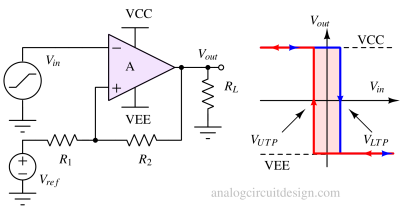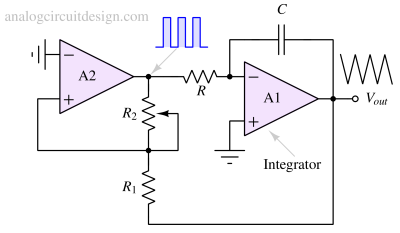RC relaxation oscillator
What is an RC relaxation oscillator? Definition¶
A relaxation oscillator is an electronic circuit that generates a repetitive output waveform (square, triangular, sawtooth, etc.) without the need for an external clock signal. Astable multivibrators generate 50% duty square waves which is a sub-category of relaxation oscillators.
Oscillators are classified into two different categories; linear/harmonic oscillators (for sinusoidal waveforms) and relaxation oscillators (for non-sinusoidal waveforms).
How to intuitively understand the operation of relaxation oscillator?¶
Relaxation oscillators operate by charging and discharging a capacitor in a continuous cycle. The voltage across the capacitor changes between two threshold levels, causing the oscillator to switch between its two states.
The components used in a relaxation oscillator circuit typically include resistors, capacitors, and sometimes transistors or operational amplifiers, depending on the specific configuration.
RC square wave relaxation oscillator¶

The op-amp comparator circuit in Fig 3 is configured as a Schmitt trigger that uses positive feedback provided by resistors R1 and R2 to generate hysteresis. These hysteresis voltages are utilized as timing thresholds to make an oscillator. An RC network is added (shown in Fig 4) which adds delay from the output pin to the inverting pin.


RC triangular wave relaxation oscillator¶
Open loop triangular waveform generator¶
 In an open-loop triangular waveform generator, a triangular wave is generated by alternatively charging and discharging a capacitor (Cint) with a constant current (Vsat/R3). Where Vsat is the magnitude of the highest and lowest voltage attained by A2. The timing is decided by the Schmitt trigger-based astable multivibrator's RC time constant.
In an open-loop triangular waveform generator, a triangular wave is generated by alternatively charging and discharging a capacitor (Cint) with a constant current (Vsat/R3). Where Vsat is the magnitude of the highest and lowest voltage attained by A2. The timing is decided by the Schmitt trigger-based astable multivibrator's RC time constant.
Closed loop triangular waveform generator¶

The basic operation of a closed-loop triangular wave generator involves charging and discharging a capacitor in a linear fashion using a timing threshold set by a Schmitt trigger (inverting mode).
The operational amplifier (A1) is configured as an integrator, with the capacitor (C) connected in the feedback loop. Initially, the capacitor is charged through a resistor (R) until it reaches a certain voltage level. Once the voltage across the capacitor (Vout) reaches a certain threshold (set by A2, R2, and R1), the output of op-amp (A2) changes direction, causing the capacitor to discharge linearly. When the voltage across the capacitor reaches another threshold, the op-amp output changes direction again, causing the capacitor to charge once more. This process repeats, creating a continuous triangular waveform.
The frequency of the triangular waveform is determined by the RC time constant in the circuit and the threshold setting resistors R1 and R2.
$$F=\cfrac{1}{4}\cfrac{R_2}{R_1}\cfrac{1}{RC}$$
Difference between relaxation oscillator and astable multivibrator¶
An astable multivibrator is a specific type of relaxation oscillator, so the key difference between them is that the astable multivibrator is a subset of relaxation oscillators. In other words, all astable multivibrators are relaxation oscillators, but not all relaxation oscillators are astable multivibrators.
A relaxation oscillator is a broader category of circuits that generate repetitive waveforms by periodically charging and discharging an energy-storage element (e.g., a capacitor). It includes astable multivibrators but can also encompass other configurations like the Schmitt trigger oscillator and triangular wave oscillator.
Application of relaxation oscillator¶
- Pulse Generators
- Signal Generators
- Timing and Delay Circuits
- Frequency Modulation (FM)
- Voltage-Controlled Oscillators (VCO)
- Motor Control
- Trigger Generators
- Sensors and Detection